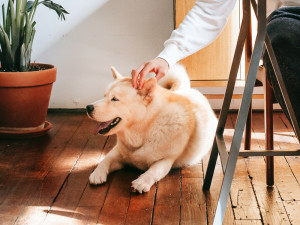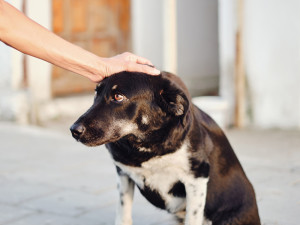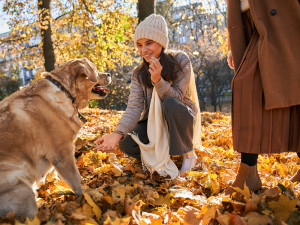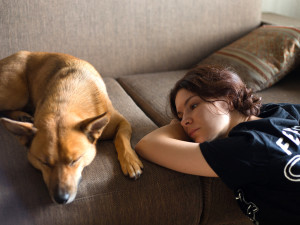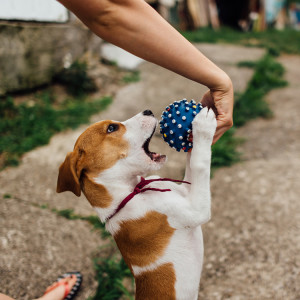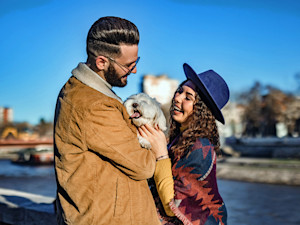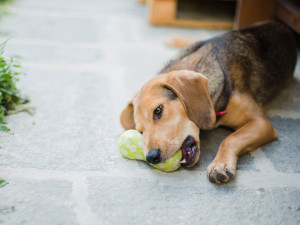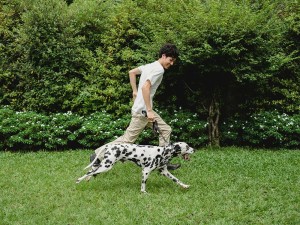Top 7 Reasons Why Dogs Growl When You Pet Them
It’s OK — they don’t suddenly hate you.

Share Article
In This Article:
Is It Normal for Dogs to Growl While Being Pet?opens in a new tab 7 Reasons Why Your Dog Growls When You Pet Themopens in a new tab What to Do When Your Dog Growls at Youopens in a new tab How to Train Your Dog to Stop Growling When You Pet Themopens in a new tab When to Consult a Professional for Growlingopens in a new tab
One minute, you’re happily petting your dog, enjoying a bonding moment, when suddenly — seemingly out of nowhere — your dog growls. The growl isn’t ferocious. It’s more like a low rumble. But it makes you pause mid-pet, wondering if you’ve crossed an unseen line.
What does it mean when a dog growls at you while you’re showing affection? Is it a warning growl? Or is your dog just being more vocal than usual?

littleKin™ is Kinship’s home just for puppy and kitten parents. Bop over to check out expert advice, new pet tools, and special deals—all curated for your newest family member.
opens in a new tabDogs communicate with us in various ways: through expressions, their tails, and even growls. However, before you assume the worst, it’s essential to understand why the growl is not always a sign of aggressionopens in a new tab, displeasure, or hostility.
Read on for expert answers to this perplexing but common dog behavior.
Main takeaways
Growling while being pet is a common form of communication, and isn’t always negative.
Key reasons for growling include feeling threatened, being in pain, overstimulation, resource guarding, fear, or even showing affection.
Understanding your dog’s body language, such as relaxed versus tense postures, helps you interpret whether the growl signals happiness or distress.
To address growling, stay calm, respect your dog’s boundaries, and use positive reinforcement to encourage relaxed behavior.
Consult a professional trainer or vet if the growling persists, becomes aggressive, or is linked to potential health issues.
Is it normal for dogs to growl while being pet?
This may be surprising, but it’s normal for some dogs to growl while being pet. However, the meaning behind the growl depends on the situation. Dogs don’t have the verbal language to tell us how they feel, so relying on growling, barking, and tail wagging is their way to get their point across.
According to Dr. Alisha Kidwellopens in a new tab, a veterinarian in North Carolina’s Cabarrus Animal Hospital, not every growl indicates negative feelings or a precursor to aggressive behavior. A playful growl can signify that your dog is enjoying your attention. It sounds like a playful yip and may be accompanied by tail-wagging and your dog nuzzling their head or body against your hand. The dog’s body language is relaxed, and they seem happy to be around you.
On the other hand, an aggressive growl signals discomfort, fear, or overstimulation. Dogs typically express negative emotions with stiff, tense body language, including a tucked tail, side-eye glance, and rigid stance.
Subtle body language cues that accompany the growl can give you a better idea of what your pup is trying to communicate.
7 reasons why your dog is growling when you pet them
1. Your dog feels threatened
Sometimes, dogs growl because they feel uneasy and threatened, which can happen in a vulnerable situation. For instance, when a pup is sound asleep in bed, sneaking up to rub their belly may cause them to give you a warning growl. The growl allows your dog to establish boundaries, signaling they don’t want to be touched in that moment.
2. Your dog is in pain
Dogs can’t outright tell you when they are hurt. If your dog growls when you pet a specific area, like their leg, tail, or back, it could be a sign of painopens in a new tab. Growls can express discomfort in the same way that whining can.
Your pup may be dealing with an injury from outside or playing with other dogs, have arthritis, or be exhibiting other health-related problems. If the growl persists or becomes more frequent, consult a veterinarian to rule out severe injuries or medical issues.
3. Your dog is overstimulated
If you’ve been playing with your dog and doling out a lot of energetic attention, they may growl when you try to pet them during their wind-down time. Overstimulation is common, especially in high-energy breeds like Border Collies, Australian Shepherds, and Jack Russell Terriers, who love to play and get excited quickly. In this case, the growl is an “I need a break” signal.
4. Your dog is resource guarding
Some dogs are possessiveopens in a new tab of their toys, food, and even favorite people. If you’re petting your pup while they eat dinner or play with their prized toy, they may growl as a warning to stay away. This is called resource guardingopens in a new tab and is natural canine behavior, but it can escalate if not addressed. Professional training can teach your dog that caring is sharing if this becomes a recurring issue.
5. Your dog is afraid
Fear is a common trigger for growling in dogsopens in a new tab. If your dog is nervous or scared, they will growl to express unease. This is especially true for adopted dogs who have had negative experiences. Fearful growls are accompanied by other signs of fear, like wide eyes, raised hackles, and a tucked tail.
If fear is the problem, approach your dog calmly and slowly, allowing them to get comfortable with your presence before you attempt to pet them.
6. Your dog has feelings of pleasure
It may seem counterintuitive, but some dogs growl to show that they love being pet. Breeds like Great Danes, Pugs, and Golden Retrievers may rumble low in their throat when they feel relaxed or happy. You can tell they are calm or content if a wagging tail, relaxed ears, and soft, affectionate eyes accompany the growl.
7. Your dog is surprised
Have you ever touched your dog when they have been in a deep sleep, only to be met with a jump and growl? Your pup was surprisedopens in a new tab and didn’t expect to be touched. Another example is if they growl when you touch their ears or paws — areas that are iffy for some dogs — and they growl as a reaction to the unexpected pressure of your hand.
What to do when your dog growls at you
Don’t panic if your dog growls while being pet. Take a breath and assess the situation. Stay calm, and avoid aggressive reactions like raising your voice or yelling. Dogs are sensitive to emotions, and your aggressive behavior could trigger theirs if you overreact.
Is your dog relaxed or tense? Look at their body language when they growl. This can help you understand your dog’s intent. For example, a comfortable dog may growl out of pleasure or contentment, while a tense pup may express fear or discomfort. If your dog is growling because they feel threatened or overstimulated, give them space. Respect their boundaries, and don’t force petting if they aren’t in the mood to be touched. Just like people, dogs are entitled to their feelings and boundaries.
When your dog is calm and relaxed, use positive reinforcement, such as treats and praise, to encourage peaceful behavior. This helps your dog associate petting and affection with positive experiences.
How to train your dog to stop growling when you pet them
Training your dog to stop growling when you pet them takes time and patience.
Desensitize your dog to touch: Gradually get your dog used to being pet. Start with short, intentional petting sessions for a few minutes several times daily, then progress to longer petting sessions as your dog becomes comfortable with being touched.
Reinforce calm behavior: Whenever your dog is relaxed while being pet,opens in a new tab reward them with treats and praise. Tell them they are a good pup. Show love in your voice. This helps your dog associate petting with positive, affectionate, and calming behavior.
Use commands to encourage positive responses: If your dog growls because of overstimulation, use words like “calm,” “settle,” or “relax” in soothing but firm tones to help them calm down.
When to consult a professional for growling
Consult a professional dog trainer or behaviorist if your dog’s growling becomes more frequent, aggressive, or paired with negative and concerning behaviors. They can help you understand underlying causes and provide strategies to better your dog’s reaction to petting. If you think a medical concern or problem is causing your dog to growl while being pet, a veterinarian can help rule out pain or illness.
Bottom line
When your dog growls while being pet, it’s not always out of aggression or angeropens in a new tab. Sometimes, it’s your dog’s way of telling you how they feel at that moment.
Your dog’s body language and emotional state play a significant role in how they are reacting to being pet.
By striving to understand their body language, you can turn growls into opportunities for better communication and deeper bonding.
FAQs
How do you respond when your dog growls at you?
Stay calm, assess the situation, and give your dog space. If your dog is growling out of pain or discomfort, stop petting them and consult a veterinarian.
Why does my dog growl when I show them affection?
It could be because your dog is overstimulated, in pain, or expressing pleasure and enjoyment. Be attentive to their body language to figure out the cause.
What does a low growl from a dog mean?
A low growl is a rumble that could indicate pleasure or contentment, especially if your dog’s body language is relaxed. It could signify that they enjoy the attention and feel connected with you.
References
“9 Most Affectionate Dog Breeds That Thrive on Human Connection.” WAF, 17 Dec. 2024, worldanimalfoundation.org/dogs/top-affectionate-dog-breeds-in-worldopens in a new tab. Accessed 31 Dec. 2024.
Gibeault, Stephanie. “Why Dogs Growl and How to Handle It.” American Kennel Club, 7 Feb. 2024, www.akc.org/expert-advice/training/why-dogs-growl-and-how-to-handle-itopens in a new tab.
“Why Does My Dog Growl When I Pet Him but Still Wants to Be Pet – [Vet Explains Pets].” Vetexplainspets.com, 2024, vetexplainspets.com/why-does-my-dog-growl-when-i-pet-him-but-still-wants-to-be-petopens in a new tab. Accessed 31 Dec. 2024.

Valerie Mellema
Valerie Mellema has a Bachelor of Science in Agribusiness and Equine Industry from West Texas A&M University. She has been a professional writer for the past 20 years, covering a wide variety of pet health and care topics before founding a nonprofit focused on mental health in children and thoroughbred aftercare. She has four Border Collies and eight retired racehorses.
Related articles
![A woman kneeling down to pet a dog sitting in a pile of colorful leaves in the woods next to the dog's owner]() opens in a new tab
opens in a new tabCan I Pet Your Dog?
Consent isn’t just for humans. Here’s how to respond when the answer isn’t so simple.
- opens in a new tab
Does My Dog Love Me? How to Interpret Canine Bonding Behavior
What to do when you don’t feel the close bond you want.
![A dog reaching up to grab a blue ball out of a woman's hand.]() opens in a new tab
opens in a new tabPlaying With Dogs Improves Their Training Success
Post-training play may extend a dog’s memory of previously learned behaviors by up to a year.
![Couple smiling and holding their small fluffy dog.]() opens in a new tab
opens in a new tabBest Dog Breeds for First-Time Pet Parents
Please remember to look at shelters and purebred rescues for your dream pup.
![Dog laying on the ground guarding toy in mouth]() opens in a new tab
opens in a new tabHow to Get Your Dog to Stop Resource Guarding Their Stuff
If your dog growls when you get near their food or toys, read this right now.
![Man running with dalmatian dog on a leash in a backyard with grass]() opens in a new tab
opens in a new tabAn Active Dog Is a Well-Behaved Dog
Why regular exercise can mean a less destructive dog and a happier you.
